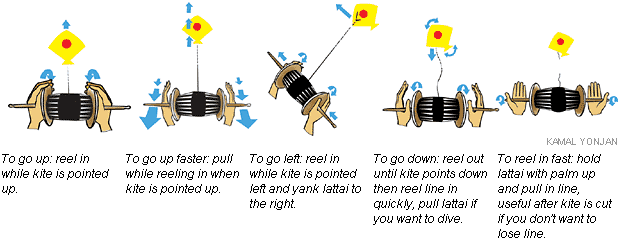
The monsoon will subside, the sky will again turn deep blue, the wind will change direction and the ripened rice fields will bloom golden. Dasain. Time to shop, party, eat, drink and.fly kites.
Kathmanduites will climb to their rooftops and terraces and the collective victory cry of 'Chaaaaaaaaaaaaaaait!' will ring in the ears of city folks. Nepali kite flying is unique-we don't fly kites just for fun, we fly kites to fight other kites. Thus, not only should your kite be easily manoeuvrable, it should obey the flyer and (ideally both) should have a killer instinct.
Nepali style kite flying requires a big reel (lattai) for the string. You hold it by two smooth sticks that protrude from each side and nestle between your thumbs and index fingers. You bring the kite closer or let it out by spinning the sides of the reel.  To start your flight, have a friend walk some distance with the kite and then toss it in the air. Simultaneously, pull the lattai toward you so the kite shoots up and into the wind. The more string you let go the higher your fighter rises. Once the kite is above ground you can manoeuvre it by reeling the string in and out.
To start your flight, have a friend walk some distance with the kite and then toss it in the air. Simultaneously, pull the lattai toward you so the kite shoots up and into the wind. The more string you let go the higher your fighter rises. Once the kite is above ground you can manoeuvre it by reeling the string in and out.
There are various ways to steer a kite. To send it left, for example, wait for the kite to point left and give the lattai a tug toward the right side of your body. The same principle applies if you want to go right, up or down. While reeling the lattai the kite often rotates so you have to be careful not to reel in while the nose is pointed down as it could send your flyer into an uncontrolled dive.
After the basics comes the battle. The way a kite behaves in the sky indicates the personality and dexterity of its pilot. Since the idea is to send the enemy kite down, you need every advantage you can get, starting with special string armoured with ground glass and a good lattai to reel in and out faster than the enemy. The winner shouts 'cha cha cha cha chaaaaaaait' and performs elaborate victory rolls when the challenger is cut adrift.
If you are in a dogfight with another kite, it is a big no-no to start rolling the sting in from your lattai. If you are smart you will let your string go, wait for your opponent to make a mistake of reeling in from his lattai, wait for friction to do its trick and watch as your opponent's kite is cut off.
The earliest written account of kite flying comes from about 200 BC when Chinese General Han Hsien flew a kite over the walls of a city he was attacking to measure how far his army would have to tunnel to reach beyond its defences. Knowing this distance his troops reached the inner city, surprised their enemy and were victorious.
It is believed that kite flying was eventually spread by traders from China to Korea and across Asia to India. Each area developed a distinctive style of kite, flying techniques and the cultural context in which to fly them. Thus, we don't know whether kite flying came to Kathmandu from the north or the south.
In the past, people used to make their own 'armoured' line, called maajhaa. Kite experts still have the secret time-tested recipes of the strongest maajhaa, reputedly made of a witch's brew of boiled slugs, aloe vera and gum, mixed with powdered florescent lamb bulbs. But caution: these have to be mixed carefully-you don't want a maajhaa that is so sharp that it cuts your own line inside the lattai.
One needs to watch out for pirates with mandalis while kite fighting. You may be so busy concentrating on the dogfight that you don't notice a surface-to-air mandali dart out of a neighbourhood roof, snare your string and capture your kite (and your enemy's too).
Choosing a kite is an art in itself. The Nepali kites have no tail, two sticks of equal lengths are crossed and tied in the center. A string pulled tight across the back of a cross-stick bows the surface making the kite self-balancing. A specialty of Nepali kites is the lokta, hand-made paper, out of which they are made.
However, these days kites made from lokta paper are becoming extinct as people prefer the lighter and more manoeuvrable 'Lucknow' variety, flattened with a conch shell and sporting distinctive stripes. Lucknows are the Spitfires among kites, with classic dog-fighting qualities: capable of sharp turns and diving attacks, they emit a hissing sound in a dive and have good line response.
The cost of a kite in Kathmandu ranges from Rs 5-50 and the lines cost Rs 200-1000. The most popular kite shops are in Asan and Kalimati.
Babache : kite with bottom half of a different colour
Chakchake : kite with attention deficit disorder
Dariwal : kite with symmetrical pattern on bottom left and right
Dharke : kite with stripes
Gwankh : paper weight to balance kite
Hi-chait : cut kite
Kakaa : string at point where it is tied to kite
Lappa : stall
Lato Changa : idle Kite
Maajhaa : line armour
Mandali : stone on string used to prey on low-fliers
Phuin : show-off kite aerobatics
Puchhare : kite with tail
Tthini : launching kite by copilot
Tiktike : sluggish side-by-side movement of kite
Tauke : kite with pattern on top quadrant


